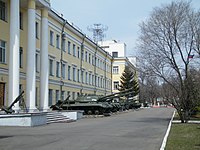5th Red Banner Army
| 5th Red Banner Army | |
|---|---|

Army headquarters at Ussuriysk
|
|
| Active | 1939–current |
| Country | Soviet Union, Russia |
| Branch | Red Army, Soviet Army, Russian Ground Forces |
| Type | Field army |
| Size | World War II: usually several corps (~10 divisions) Postwar: 5-7 divisions |
| Garrison/HQ | Ussuriysk |
| Engagements |
Invasion of Poland Operation Barbarossa Battle of Moscow Soviet invasion of Manchuria others |
The 5th Red Banner Army is a Russian Ground Forces formation in the Far East Military District.
It was formed in 1939, served during the Soviet invasion of Poland that year, and was deployed in the southern sector of the Soviet defences when the German Operation Barbarossa began in June 1941 during World War II. In the disastrous first months of Barbarossa, the 5th Army was encircled and destroyed around Kiev.
Reformed under Lelyushenko and Govorov, it played a part in the last-ditch defence of Moscow, and then in the string of offensive and defensive campaigns that eventually saw the Soviet armies liberate all of Soviet territory and push west into Poland and beyond into Germany itself. The 5th Army itself only advanced as far as East Prussia before it was moved east to take part in the Soviet attack on Japan. Since 1945 under the Soviet and now Russian flag it has formed part of the Far East Military District keeping watch on the border with the People's Republic of China.
The 5th Army was created in August 1939 in the Special Kiev Military District from the Northern (originally Shepetovskaya) Army Group. In September 1939 the 5th Army took part in the Soviet invasion of Poland, which had been justified by the Molotov-Ribbentrop Pact. The Army was originally placed under the command of I.G. Sovietnikov.
On 22 June 1941, the 5th Army consisted of the 15th Rifle Corps (under Colonel I.I. Fedyuninsky and incorporating the 45th Rifle Division and 62nd Rifle Divisions), as well as the 27th Rifle Corps (87th, 125th, 135th Rifle Divisions), the 22nd Mechanised Corps (19th, 41st Tank Divisions, 215th Mechanised Division), the 2nd Fortified Region, seven artillery regiments, 2 NKVD border regiments, and an engineer regiment.
...
Wikipedia
